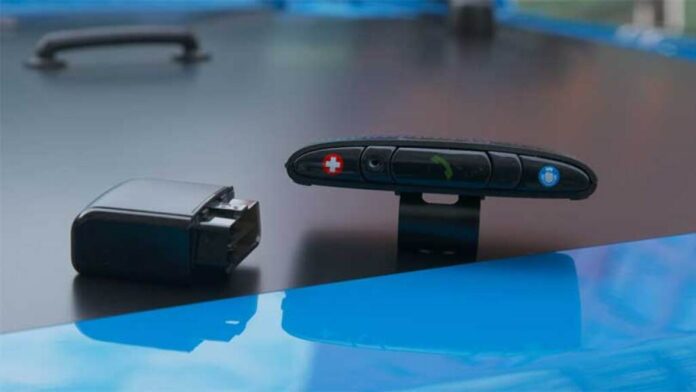PROS
- Easy setup.
- Intuitive app interface.
- Automatic maintenance checks and reminders.
CONS
- Crucial services depend on cellular coverage.
- Pricey.
Pricing, Design, and Features
Verizon Hum consists of an ODB-II dongle, a Bluetooth-enabled speaker/control unit that clips to your car’s sun visor, a USB charging cable for the speaker with a cigarette lighter adapter, and a companion Android and iOS smartphone app. Hum costs $14.99 per month, and if you sign up for a two-year subscription you get the first month free. The equipment comes at no extra cost with the service, and additional vehicles cost $12.99 each per month.
For this monthly fee you get roadside assistance up to four times a year by pressing a button on the control unit labeled with an operator symbol (or via the smartphone app). You can also press another button with a cross symbol to get emergency assistance via a 911 call. The system automatically detects when a crash has occurred and an airbag has deployed, and will immediately call the driver to assess the situation. If the driver doesn’t respond, Hum will call 911 for emergency assistance, relay your location, and stay on the line until help arrives. If your car is stolen, Hum can send its location to local law enforcement once you file a police report
 If you’re not in need of immediate assistance, Hum offers other features, mainly through the smartphone app, but also via a Web portal. Using data collected from your car through the ODB-II port, the app keeps tabs on fuel economy, battery charge level, transmission coolant temperature, and engine diagnostic error codes, and will notify you of any issues. If your car generates an error code, the app explains what it means, recommend repairs, and even provide an estimate for what it will cost.
If you’re not in need of immediate assistance, Hum offers other features, mainly through the smartphone app, but also via a Web portal. Using data collected from your car through the ODB-II port, the app keeps tabs on fuel economy, battery charge level, transmission coolant temperature, and engine diagnostic error codes, and will notify you of any issues. If your car generates an error code, the app explains what it means, recommend repairs, and even provide an estimate for what it will cost.
 Verizon Hum
Verizon Hum
If your car has a problem, a hotline can connect you to a mechanic who will help to diagnose it. Hum can also remind you where you parked your car, when the meter’s set to expire, and offers discounts on auto parts and service, rental cars, and hotels. Finally, the Bluetooth speakerphone unit can be used to make hands-free calls.
Road Testing Hum
We plugged the Hum OBD-II device into a 2008 Honda CR-V and drove around for a bit, per the instructions. When the device is first activated, an operator comes on the speakerphone to walk you through any setup issues and answer your questions, which is helpful. Downloading the app and registering for the service is also straightforward.
Fortunately, during our time testing Hum, we never had to use of any of the emergency services, but it was good to know that they were available. One caveat: Many services require a cellular signal and/or GPS service, which means they aren’t available if you’re out of Verizon’s coverage area. For example, we tried to call for roadside assistance while we were out of a cellular coverage area, but couldn’t get through.
 Verizon Hum
Verizon Hum
The app provides a wealth of info about your car’s mechanical condition and other data, and does so in an easy and intuitive manner. The main screen has tabs that allow you to set maintenance reminders, call for roadside assistance, check available discounts, and, when parking, take a picture and write a note about the spot and set a meter timer. A submenu lets you set notifications via the app, email, or text for everything from vehicle recalls to a low battery, as well as tabs for stolen vehicle assistance, a quick start guide, support, and more. The Web interface is similarly easy to navigate.
Conclusions
We like that Hum is straightforward and easy to use, and it’s good for drivers to have a backup other than their mobile phone. But we question paying almost $180 a year for it. While it’s difficult to put a price on the peace of mind that comes with knowing you can get immediate help after an accident, in an emergency, or when your car breaks down, there are other services that offer similar features via a smartphone app, like Honk and Urgent.ly, at a low or no cost. And there are many car maintenance apps that provide the same info as Hum, albeit not quite as intuitively. There are also plenty of other connected pay-to-play OBD-II dongles to choose from, such as Automatic and Zubie, which both cost $99 per year and offer additional features.




